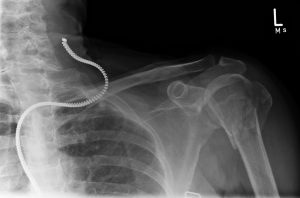Upper Limb Fractures Mask a More Serious Condition

A 75-year-old man presented to an orthopaedic surgeon at Duke Health with multiple fractures in his upper limbs following a bicycle collision that resulted in a hard fall. The patient was still experiencing severe pain following regional emergency treatment, so the patient’s wife sought consultation with Marc J. Richard, MD, an orthopaedic specialist in elbow, wrist, and hand procedures. The patient wanted a more comprehensive work-up.
Richard diagnosed and repaired 3 arm fractures in the patient, who was released for recovery at home.
However, the patient returned within weeks with complaints of persistent numbness alternating with arm pain. Richard recognized the potential for neck or spine conditions as sources of this patient's pain, so he referred him to Melissa M. Erickson, MD, an orthopaedic surgeon and spine specialist at Duke.
Questions: What condition was masked by the upper limb fractures? What procedure did Erickson perform to relieve the condition?
The patient, who is an active hiker and bicyclist, reported relief within days.
“This was a classic distracting injury,” Erickson notes. “The arm fractures masked the severe neck injury. After my partner repaired the arm, the patient began to feel the background noise of pain from another condition.”
Prior to cervical laminectomy, the patient’s arms hurt so badly that he donned protective sleeves designed for biking to help distract him from the pain.
Postoperatively, the patient reports that his strength is continuing to return in his arms and upper torso. After a 3-month check-up visit last spring, Erickson says the patient was shopping for a new bicycle.
Because of the patient’s excellent condition—he is physically younger than 75 years of age because of regular physical activity, Erickson says—he responded well to surgery.
“By taking pressure off the spinal cord at multiple points, we were able to dramatically improve his condition,” Erickson says. “Not everyone responds as well as he did to this complex procedure.”
Advanced intraoperative neurologic monitoring was used to ensure the patient's safety, Erickson adds. Monitoring technicians preoperatively positioned electrodes at key sensorimotor junctions so that a neurologist could intraoperatively monitor function.
“The proximity of subspecialty partners who work together to recognize distracting injuries and help identify the cause of pain is a major advantage at Duke,” Erickson says. “We can collaborate with another expert we work with every day.”